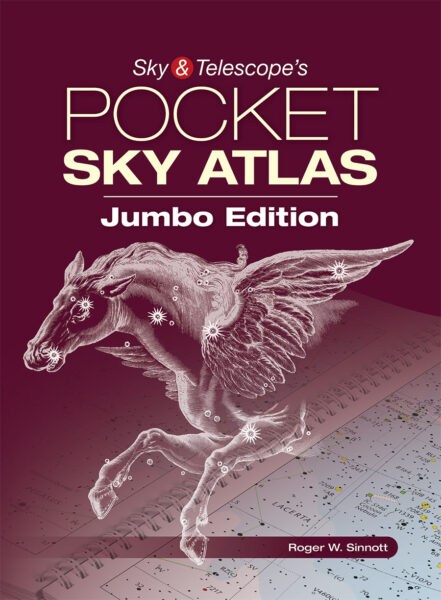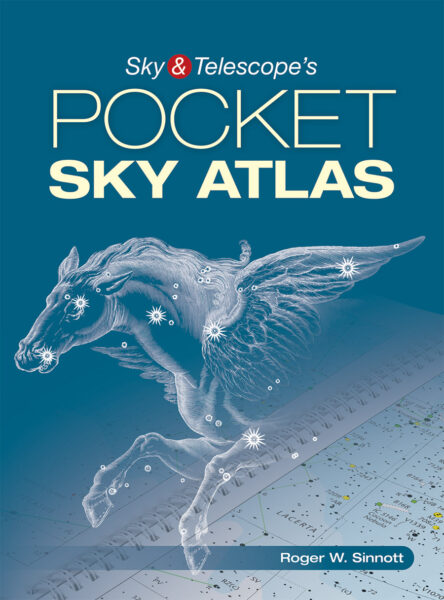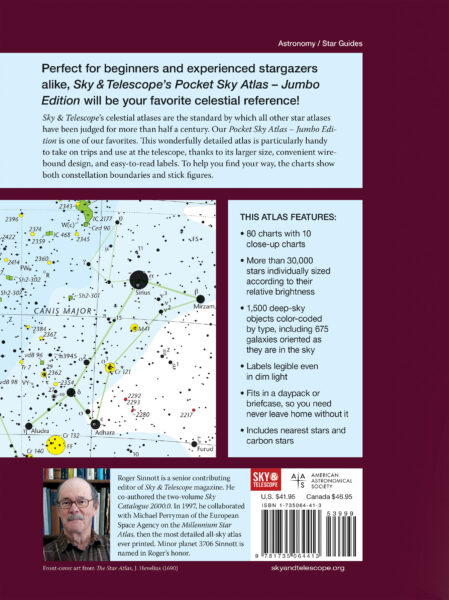Sky & Telescope presents the second edition of its most popular celestial atlases, the Pocket Sky Atlas and the Jumbo Pocket Sky Atlas!


Ever since Sky & Telescope first introduced the Pocket Sky Atlas in 2006, and then the Jumbo version in 2015, the atlases’ enthusiastic acceptance has been more than gratifying. Taken together (for they differ only in page size), they’ve been the magazine’s most popular celestial atlas throughout the last 15 years. This is warm testimony to the months of brainstorming and planning by the whole editorial staff that went into crafting the book’s 80 charts in the preproduction stage.
Both versions are now out in a new 2nd edition. The changes aren’t major, but they could be significant for some users. As you’d expect for any widely used product, sharp-eyed observers have kindly alerted us to some misleading labels and other minor flaws on the charts. We’ve fixed those and done a few more things.
For example, we already had more than four dozen carbon stars marked on the charts, notable for their striking reddish hue in amateur telescopes. But users have asked us to list them separately so they could be hunted down in a more systematic fashion. A new table in the back answers this plea, tallying all 53 of these stars with their variable-star designations and the charts on which they are plotted.
Others have wanted better information on nearby stars, which often come up in stories about newly discovered exoplanets. We now have a list of 24 very nearby stars, all within just 5 parsecs (16.3 light-years) of our solar system, together with their names, distances in light-years, and the charts where they can be found. About half of these were already in the atlas but not specially marked, and the rest (those just fainter than the atlas’s cutoff of magnitude 7.6) now have their locations marked on the charts as well. All of them are easily picked up with a small telescope.

Ava Pope
We’ve also corrected a few old star names to agree in spelling with the International Astronomical Union’s 2018 list of officially approved names. For instance, the old-fashioned Al’Nair is now Alnair (chart 79), and Sterope in the Pleiades is now Asterope (close-up chart A).
No doubt about it, a new generation of customers will be treating themselves to a thoroughly field-tested and mature product. Which version of the 2nd edition to choose — regular or Jumbo — is very much a matter of taste. Just ask yourself if you’d rather tote a small, ultra-handy sky guide, perhaps literally in a coat pocket, on trips to your favorite observing site. Or can you accept something a little bulkier in exchange for larger chart pages, highly readable under very dim light at the telescope? Whatever your decision, we’re sure you won’t regret it.
Click here for more info, more sample charts, and to purchase the Pocket Sky Atlas, 2nd edition.
Click here for more info, more sample charts, and to purchase the Jumbo Pocket Sky Atlas.

 23
23





Comments
Anthony Barreiro
August 12, 2020 at 3:59 pm
The first edition of the Pocket Sky Atlas was based on Wil Tirion and Roger Sinnott's Sky Atlas 2000.0. Stars are plotted at their Epoch J2000.0 positions, where they appeared in the sky on 1 January 2000. Is the second edition also plotted at the same epoch?
Has the IAU made a decision when we will start using Epoch J2050.0, or some other epoch?
I have a collection of sky atlases, most bigger and more detailed than the Sky and Telescope Pocket Sky Atlas, but the Pocket Sky Atlas gets more use than all the others combined. I keep it close at hand when I'm reading about the sky, so I can quickly find what I'm reading about. The pocket atlas and a red flashlight always go with me when I'm out skywatching. The charts are organized so that it's easy to see what's visible at any given time from north to south with minimal page flipping.
I have a copy of the jumbo edition, but it stays on the shelf. The pocket atlas is the perfect size to use as both a quick desk reference and a handy field guide under the stars.
You must be logged in to post a comment.
Roger W. SinnottPost Author
August 14, 2020 at 5:51 pm
Thanks for your comments, Anthony. You're right, these 2nd editions continue to use the equinox 2000.0 reference frame. This is so the coordinate grid will be fully consistent with the positions announced for newly discovered comets, novae, and other objects described in Sky & Telescope and other modern magazines and books. Also, most GoTo telescopes are designed to accept 2000.0 positions. (If an atlas were plotted for some other equinox, you'd have to correct for precession every time you went to plot something among the stars -- a huge nuisance.)
Eventually, I'm sure astronomers will switch over to 2050.0, and then it will make sense to issue new atlases accordingly. On the other hand, I've heard rumors some scientists would like to continue using 2000.0 forever! (Personally, I hope that doesn't happen. It would be like the terrible idea to abolish leap seconds.)
Roger
You must be logged in to post a comment.
Anthony Barreiro
August 14, 2020 at 8:25 pm
Thanks Roger. I appreciate knowing that 2000.0 coordinates will remain the standard for the foreseeable future. But it will make sense to update all the charts and computers to account for precession at some time in the future. Reality can be inconvenient, but ignoring reality causes deeper problems in the long run. The analogy to leap seconds is apt.
I don't understand the difference between epoch and equinox, but as a humble skywatcher I probably don't need to. If I can get within a binocular or finder scope field of what I'm looking for, that's good enough for me.
You must be logged in to post a comment.
Roger W. SinnottPost Author
August 16, 2020 at 7:17 am
"Equinox 2000.0" means the coordinate grid has its equinox (0h R.A., 0 deg Dec.) at the point along the ecliptic where it was at the start of the year 2000. The grid system and equinox precess, relative to the stars as a whole, by about 1.4 degrees per century along the ecliptic. This is the most obvious change over time.
"Epoch 2000.0" means that individual stars with a sizable proper motion are shown they were in year 2000 with respect to the bulk of other stars (as well as to the equinox-2000.0 grid). The fastest-moving star is Barnard's Star, marked by a "+" on chart 65 because it is fainter than the atlas's magnitude cutoff. In 20 years, this star has moved 0.28 mm (about 1/100 inch) northward on the regular PSA chart, or 0.36 mm on the Jumbo charts.
To get overly pedantic, the grid of these atlases shows right ascension and declination for "equinox, equator, and epoch 2000.0."
Roger
You must be logged in to post a comment.
Anthony Barreiro
August 16, 2020 at 6:20 pm
Thanks for the explanation. I wasn't making the connection between "equinox" and "first point of Aries." Now it makes sense. And, of course, that's where the term "precession of the equinoxes" comes from.
I appreciate you taking the time to explain both the concepts and their practical importance.
You must be logged in to post a comment.
Weixelman
August 14, 2020 at 3:18 pm
My GoTo star atlas. I even use the jumbo edition most of the time in the field. Easy to read and just the right amount of fine detail.
You must be logged in to post a comment.
Roger W. SinnottPost Author
August 16, 2020 at 6:07 am
Thanks!
You must be logged in to post a comment.
rrpallechio
March 12, 2022 at 3:09 pm
Any update as to when the Jumbo Sky Atlas will be available?
You must be logged in to post a comment.
alanspurgeon
February 10, 2024 at 1:46 pm
Yes, please do another print run!
You must be logged in to post a comment.
Monica Young
February 12, 2024 at 10:46 am
Hi Alan, The Jumbo Pocket Sky Atlas is available here: https://shopatsky.com/products/jumbo-pocket-sky-atlas-second-edition
You must be logged in to post a comment.
Jan Galkowski
August 14, 2020 at 5:00 pm
Hi. How do these compare to the SkEye Pro app for Android?
You must be logged in to post a comment.
Roger W. SinnottPost Author
August 16, 2020 at 7:21 am
Sorry, I don't have an Android. Maybe someone else can comment. /Roger
You must be logged in to post a comment.
Harold Corwin
August 14, 2020 at 9:57 pm
Hi, Roger,
There is one critical piece of information missing -- at least buried out of my sight! -- that I need in order to choose between the regular Pocket Sky Atlas and the Jumbo edition: how big are they?! Inches, centimeters -- either will do.
Thanks!
Harold
You must be logged in to post a comment.
Roger W. SinnottPost Author
August 16, 2020 at 6:06 am
Harold: Gosh, I'll try to get that included in the descriptions! Thanks for pointing out this omission.
The regular Pocket Sky Atlas has 6.5-by-9-inch covers and 6-by-9-inch chart pages. Chart scale is about 48mm per 10 degrees.
The Jumbo version has 9-by-12-inch covers and 8.3-by-11.8-inch chart pages. Chart scale is about 63mm per 10 degrees.
Roger
You must be logged in to post a comment.
Bob
August 17, 2020 at 11:45 pm
The classic PE is my standard starting point (tho I endorse Interstellerum for fine detail). With my farsighted vision I've thought for a while about the Jumbo. The carbon star tabulation is a great idea and clinched the order for me! I look forward to receiving the JE when circumstances permit.
You must be logged in to post a comment.
rrpallechio
January 27, 2022 at 1:39 am
When will the Jumbo version be available?
You must be logged in to post a comment.
Monica Young
January 27, 2022 at 10:53 am
We are in the process of re-ordering the Jumbo Pocket Sky Atlas, and it should be available by late February.
You must be logged in to post a comment.
Marker
March 11, 2022 at 10:06 am
Hi Monica, I still don't see these available any ideas when they may be ready?
You must be logged in to post a comment.
Monica Young
March 14, 2022 at 10:42 pm
Hi Mark, please email [email protected], they can then put you in touch with the right person to answer this question!
You must be logged in to post a comment.
4dmaze
June 10, 2023 at 3:54 pm
Are all the atlases spiral bound? Couldn't find the binding info. Thanks.
You must be logged in to post a comment.
Monica Young
June 12, 2023 at 10:04 am
Yes, the Pocket Sky Atlas is wire-bound: https://shopatsky.com/products/pocket-sky-atlas-second-edition
You must be logged in to post a comment.
Roger W. SinnottPost Author
June 13, 2023 at 8:54 am
Yes -- the type of binding is called Wiro-O (slightly different from spiral). Both the small and jumbo sizes will lie perfectly flat on a table when opened to any page spread. Both have spines, too, which hide the wires from view when the atlas is on a bookshelf between other books. And with either version, after you open the book you can fold it ALL THE WAY back on itself, making it easier to hold in one hand when you use the other hand to adjust a telescope.
You must be logged in to post a comment.
dchooper
February 17, 2024 at 12:15 am
Any idea how much longer the regular (i.e. blue) version of the 2nd edition will be out-of-stock? I can't seem to get a response about it by contacting [email protected]
Clear skies!
You must be logged in to post a comment.
You must be logged in to post a comment.